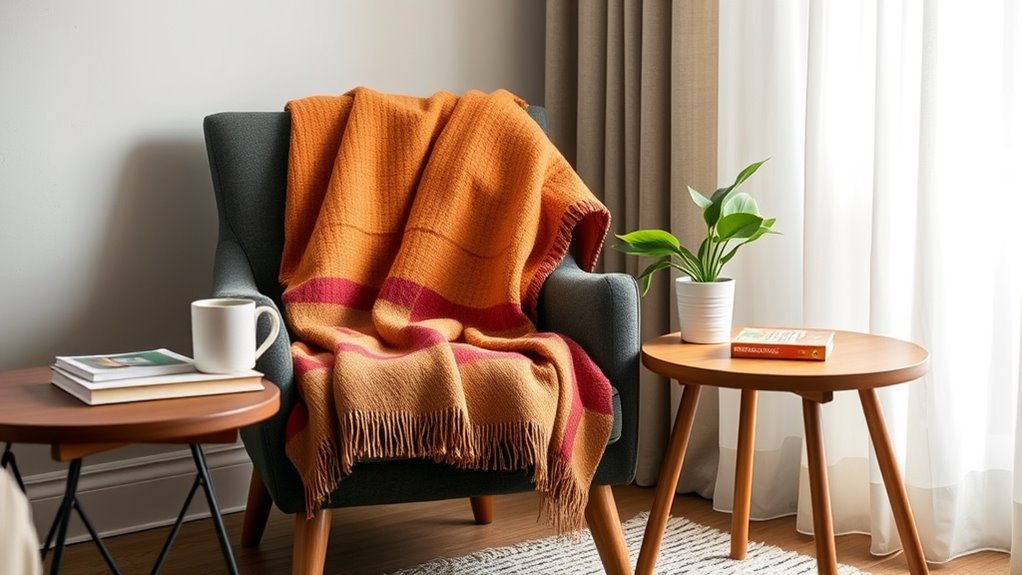Borrowing before buying helps you cut down on unnecessary spending and clutter while promoting sustainable habits. When you share items with others, you reduce waste, extend the life of products, and make more mindful choices. Using community tools or gadgets allows you to test products without committing, which can lead to smarter purchases. If you want to discover more about how borrowing can transform your consumption habits, keep exploring this approach.
Key Takeaways
- Borrowing allows testing items before committing to purchase, ensuring they meet your needs and preferences.
- It reduces unnecessary spending and clutter by prioritizing sharing over ownership.
- Access to shared resources supports eco-friendly habits and decreases environmental impact.
- Borrowing fosters community connections and encourages responsible, mindful consumption.
- Proper maintenance of borrowed items extends their lifespan, promoting sustainability and waste reduction.

Have you ever wondered if borrowing something before making a purchase could save you money or prevent regrets? It’s a smart question, especially in today’s world where the sharing economy is transforming how we access goods. Instead of rushing to buy every new gadget or tool, you can consider peer lending or borrowing from others. This approach not only helps you save money but also reduces unnecessary clutter and consumption. When you borrow instead of buy, you make more mindful choices about what you truly need, and you lessen your environmental footprint.
Borrowing before buying saves money, reduces clutter, and promotes mindful, eco-friendly choices.
The sharing economy makes it easier than ever to connect with others who are willing to lend items temporarily. Platforms dedicated to peer lending allow you to borrow everything from power tools to camping gear, often at a fraction of the retail price. You might find that borrowing a high-end camera or a specialized kitchen appliance for a one-time project makes more sense than purchasing it outright. By participating in the sharing economy, you tap into a community of people who are encouraged to share resources, which promotes a more sustainable and cost-effective lifestyle.
When you borrow through peer lending, you also avoid the pitfalls of impulse buying. Instead of purchasing something you’ll only use once or twice, you can test it out first. This helps you determine if it’s truly worth the investment before committing your money. Plus, borrowing allows you to experience products you might not otherwise afford or justify. If you discover that you love a particular hobby or activity after borrowing the equipment, then you can decide whether to buy it later. This approach leads to more mindful consumption, where your buying decisions are driven by real need rather than fleeting desire.
Furthermore, borrowing reduces waste. When you share or lend items, you extend their lifespan and keep them out of landfills longer. It fosters a community mindset, where trust and reciprocity play essential roles. You get to connect with neighbors or like-minded individuals, building relationships while also saving money. It’s a win-win situation—you’re able to access what you need without the burden of ownership, and others benefit from your willingness to share.
In essence, borrowing from the sharing economy and engaging in peer lending encourages you to think differently about consumption. It helps you make smarter financial choices, minimizes waste, and supports a more sustainable lifestyle. The next time you consider buying something, ask yourself if borrowing first might be a better option. Proper equipment maintenance is also crucial, as it ensures borrowed items remain in good condition for future use. It’s a simple step that can lead to big savings and a more mindful way of living.
Frequently Asked Questions
How Do I Determine if Borrowing Is Sustainable Long-Term?
To determine if borrowing is sustainable long-term, you need to assess your financial sustainability and borrowing frequency. If you can consistently repay loans without straining your finances, and your borrowing frequency remains low, it’s more likely sustainable. Keep track of your income, expenses, and debt levels. Avoid frequent borrowing for non-essential items, and verify your repayment plan fits your long-term financial goals.
What Are the Best Platforms for Borrowing Items Locally?
You should explore platforms like Peerby, Fat Llama, and local community sharing apps to borrow items nearby. These platforms facilitate local exchange, allowing you to access tools, gadgets, or household items without buying. They promote community sharing, reduce unnecessary consumption, and foster neighborly connections. By using these services, you can save money and minimize environmental impact while responsibly borrowing what you need from people in your area.
How Can I Ensure Borrowed Items Are Returned in Good Condition?
Treat borrowed items like fragile treasures, and you’ll naturally uphold your responsibility standards. Before returning, inspect their return conditions carefully—check for damage, cleanliness, and proper functioning. Handle items with care, keep them organized, and communicate openly with the owner about any issues. By respecting these standards, you guarantee your reputation stays shining and trustworthy, making borrowing a smooth, mutually respectful experience for everyone involved.
Are There Legal Considerations When Borrowing or Lending Items?
Yes, there are legal considerations when borrowing or lending items. You should understand your legal obligations, such as responsibility for damage or loss, which relates to liability concerns. It’s wise to have clear agreements about the terms, including how damages are handled and who’s liable. Being aware of these legal obligations helps protect both parties and ensures that borrowing or lending is smooth and responsible.
How Does Borrowing Impact My Personal Relationships?
Ironically, borrowing can strengthen your relationships if you practice good borrowing etiquette. By communicating openly and respecting boundaries, you build trust rather than strain it. When you’re clear about what you need and return items promptly, you foster mutual respect. But forget these steps, and even friendly bonds might fray. So, think of borrowing as an act of trust—nurture it with honesty and respect, and your relationships will flourish.
Conclusion
So, next time you’re tempted to splurge, remember—borrowing before buying can turn your wallet into a superhero, saving it from the villain of overspending! Imagine your bank account soaring higher than a rocket, all because you chose to borrow wisely. It’s like giving your finances a superhero cape—ready to conquer any shopping temptations with a single, smart move. Embrace this trick, and watch your money stay safe, sound, and ready for anything!








